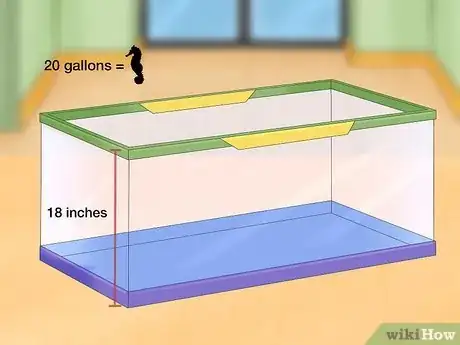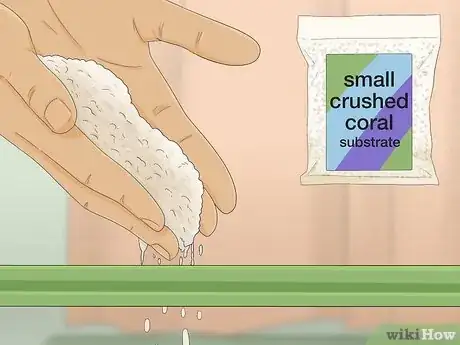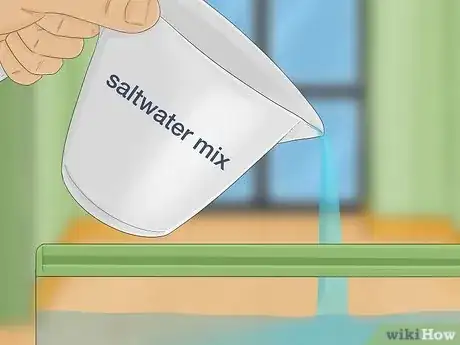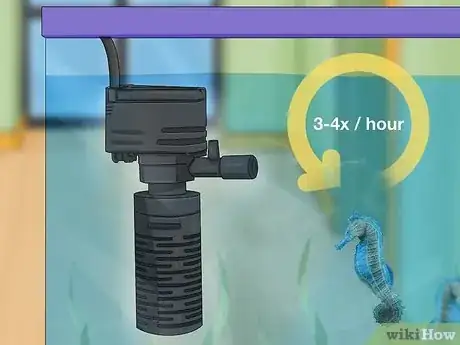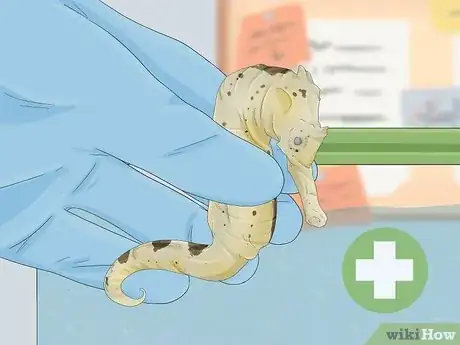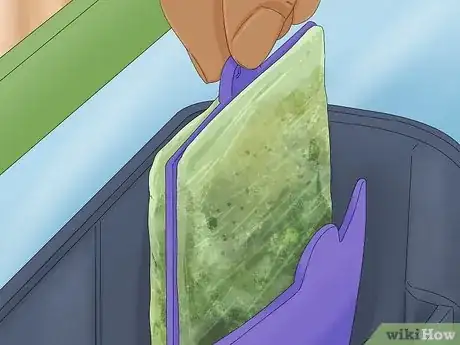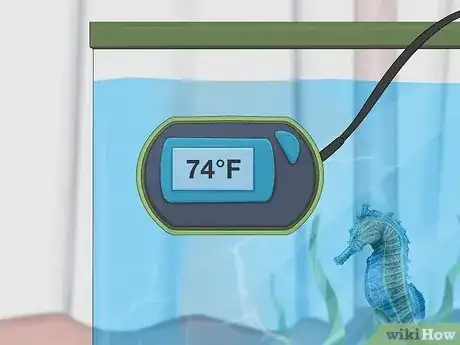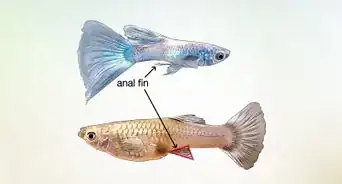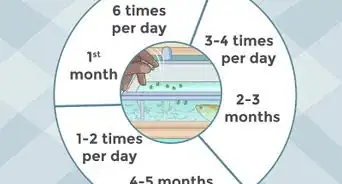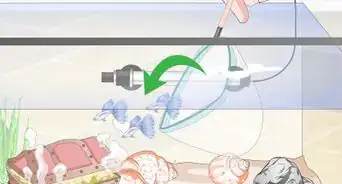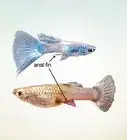This article was co-authored by wikiHow Staff. Our trained team of editors and researchers validate articles for accuracy and comprehensiveness. wikiHow's Content Management Team carefully monitors the work from our editorial staff to ensure that each article is backed by trusted research and meets our high quality standards.
wikiHow marks an article as reader-approved once it receives enough positive feedback. In this case, 100% of readers who voted found the article helpful, earning it our reader-approved status.
This article has been viewed 60,691 times.
Learn more...
Seahorses are magical animals that have captured the attention of people for hundreds of years. There are about 36 different species of seahorses with striking colors and distinct personalities throughout the world’s oceans. Although seahorses are different from fish, they require the same basic care in home aquariums. You can care for your seahorse by setting up a clean and comfy tank, maintaining its daily needs, and cleaning the aquarium weekly.
Steps
Setting up Your Aquarium
-
1Purchase a tank. Buy a new or refurbished tank for your seahorses because it can be difficult to add them to an established aquarium. Keep in mind that seahorses are vertically orientated, so opt for a tank that is at least 18” tall. Calculate approximately 20 gallons of water per seahorse. Wash any tanks you get before introducing your seahorses into them.
- Get the biggest tank you can afford so your seahorses can flourish. Consider a second-hand tank if you’re trying to save money.
- Figure in sand beds and other aquarium features when calculating the size. For example, a 20-inch (50 cm) tank with a 6-inch (15 cm) sand bed only offers your seahorse 14 inches (35 cm) of usable height.
-
2Place the tank in a shady and cool area. Seahorses prefer spaces that are not as light or warm as other fish. Place the seahorse tank in a location that is not exposed to extreme heat or direct sunlight and can maintain a tank temperature of 74 to 76 degrees Fahrenheit (21 to 25 degrees Celsius). This can ensure the health and happiness of your seahorse.
- Place the tank in a spot that is either air-conditioned or in a cool part of your home.
Advertisement -
3Add substrate. Use small crushed coral or sand to line the bottom of your tank. The substrate should be about 2-2.5 inches (5-6.5 cm) in height, which is about 10 pounds (4.5 kg) of the substrate.[1] This not only decorates the tank but also provides surfaces on which you can hook hitching posts for the seahorses.
- Avoid putting too much substrate in your tank. This can cause food to fall into the substrate and create hydrogen sulfite, which is toxic to seahorses.[2]
-
4Fill the tank with saltwater. Mix saltwater for your tank using fresh, clean, and dechlorinated tap water with a sea salt mix. Place your fresh water in a storage bucket and add a water purifier to dechlorinate it. Wait two hours and add aquarium salts per the package instructions. Then pour it into your tank.
-
5Filter the water. Add one large or several small filters to the water. Make sure the water will turn over the entire water volume 3-4 times per hour. This can ensure the health of your seahorses, which can produce a considerable amount of waste.
- Get a filter with a lower water flow. Seahorses can be sensitive to water flow because they are relatively weak swimmers.
-
6Decorate your tank. Choose a selection of real and faux items to decorate the tank. These can give your seahorse ideal places to rest and hide. Use any of the following to spruce up your tank and help keep your seahorse happy and healthy:
- Rock
- Coral
- Plants
- Gorgonias[3]
- Macro algae
Maintaining Your Seahorse’s Health
-
1Feed your seahorses twice per day. Give your seahorses a selection of frozen Mysida shrimp, small krill, and brine shrimp twice each day. Place about 50 krill or shrimp per seahorse in the tank at each feeding. Siphon off anything the seahorse doesn’t eat. This can ensure your seahorse gets proper nutrition. It also ensures that old food doesn’t create toxic hydrogen sulfite.[4]
- Ask if a local aquarium dealer has live diets available for seahorses. Give this to your seahorse occasionally to boost its nutrition.
-
2Introduce tank mates with caution. Consider keeping your seahorse tank only for your seahorse or other seahorses. Add other types of tank mates with care. Many other species are not ideal mates for seahorses because they may consume your seahorse’s food. Some may even make your seahorse the meal. The following tank mates may cohabitate best with your seahorse:
- Snails
- Limpets
- Goby
- Blenny
- Clownfish
- Tangs
-
3Observe healthy traits. Check-in on the health and vitality of your seahorses every day. Look for signs of its health during feedings. This can alert you to potential issues so you can treat them quickly. The following traits are signs of a healthy seahorse:
- Active, moving around
- Bright active eyes that swivel around searching for food
- Clear fins
- Full, round belly
-
4Watch for disease. Just as it’s important to observe signs of health, it’s vital to notice any potential symptoms of the disease. This can ensure you get prompt care and treatment for your seahorse. Symptoms of disease in seahorses includes:
- Cloudy eyes
- Little eye movement
- White, gray, or inflamed growths
- Heavy breathing, panting, or coughing
- Bloating
-
5Seek veterinary care. Consult a vet if your seahorse has any signs of disease. They can diagnose the problem and provide proper treatment. This may include popping air bubbles, prescribing medication, or giving the seahorse an antibiotic. Prompt veterinary care can ensure the health of your seahorse and tank mates.
- Let the vet know what specific symptoms your seahorse has, including when they started and what you’ve done to care for your pet.
Maintaining the Tank
-
1Invest in a “cleaning crew.” Introduce tank mates to your seahorse that have a dual purpose: company and cleaning. Certain species of marine life can help maintain the tank’s cleanliness from day to day. The best and safest cleaning crew members for your seahorse’s tank include:[5]
- Brittle or serpent star
- Lettuce nudibranch
- Sea cucumbers
- Sea hares
- Peppermint or coral-banded shrimp
-
2Check the filters daily. Sea horses are sensitive to their water flow and environment. Make sure that the tank filters and working properly at least once a day. Remove and either clean or replace any filters that are clogged, dirty, or not functioning properly. This can keep your seahorse healthy by removing excess food, decaying organic matter, and free-floating particulate, toxic chemicals, and waste products from the water.[6]
-
3Measure the water temperature every day. Place an aquarium thermometer inside the tank. Check the water temperature every day during one of the feedings. The temperature should be between 74 and 76 degrees Fahrenheit (23-24 degrees Celsius). This can prevent and reduce possible odors and ensure the health of your seahorse.
-
4Clean the tank weekly. Fresh and clean water is important to maintaining the health of your seahorse. Replace 10-20% of the water once every week. Wipe down the tank walls and any decorations. Replacing the water regularly can prevent unpleasant odors and maintain the health of your seahorse.[7]
Community Q&A
-
QuestionCan I make my own salt water, or must I collect it from the beach?
 Community AnswerYou are able to make your own salt water, as long as you follow the precautions for making it correctly.
Community AnswerYou are able to make your own salt water, as long as you follow the precautions for making it correctly. -
QuestionWhere can I find sea horse food?
 Community AnswerYou can probably find sea horse food (like frozen mysis shrimp) at local pet stores, or online, depending on where you live.
Community AnswerYou can probably find sea horse food (like frozen mysis shrimp) at local pet stores, or online, depending on where you live. -
QuestionHow long do sea horses live?
 Community Answer1-5 years.
Community Answer1-5 years.
Things You'll Need
- Tank
- Seahorse food
- Tank filter
- Decorations including hitching posts
References
- ↑ https://www.algone.com/substrate-for-aquariums
- ↑ https://www.algone.com/substrate-for-aquariums
- ↑ https://www.algone.com/keeping-seahorses-in-the-aquarium
- ↑ https://www.algone.com/substrate-for-aquariums
- ↑ http://www.seahorse.org/library/articles/cucbasic/cucbasic.shtml
- ↑ http://www.firsttankguide.net/filters.php
- ↑ http://www.firsttankguide.net/fish-tank-maintenance.php
About This Article
To care for a seahorse, feed it about 50 frozen krill or brine shrimp twice a day, and remove any leftover food to prevent toxins from forming in the water. You can also purchase live diets for your seahorse from your local aquarium store to boost its nutrition. Additionally, check the water filters daily to make sure they're not clogged or dirty. Once a week, wipe down the tank walls and replace 20 percent of the water to avoid unpleasant smells and keep your seahorse from getting sick. For tips on how to introduce tank mates to your seahorse, read on!
